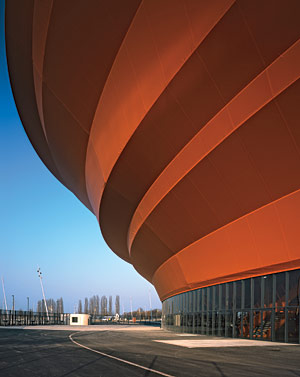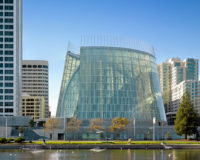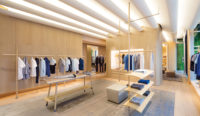Eckbolsheim, France
Massimiliano and Doriana Fuksas
It is striking to discover the unabashedly futuristic architecture of spectacle of the Zenith concert halls cropping up on the outskirts of French towns and cities often best known for the soaring spires of their Gothic cathedrals.The nation’s effusive embrace of modernity and mass culture does indeed generate unexpected juxtapositions with the architectural artifacts of its past. This pronounced disconnect between the contemporary concert hall and the medieval church may be unintentional, but it seems to underscore France’s desire both to acknowledge its historic patrimony and establish a critical distance from it. Bernard Tschumi compellingly emphasized the dichotomy between the two cultures with his concert hall in Rouen, whose 13th-century cathedral provided a mesmerizing subject for the Impressionist painter Claude Monet. While Tschumi refined his concert hall design with different materials for the Zenith in Limoges, Massimiliano and Doriana Fuksas further accentuate and celebrate the schism between the two time periods and architectural types with their own Zenith music hall outside Strasbourg. Their colorfully jaunty design offers a cheeky correlative to the late-13th-century Gothic cathedral, famous for a delicate vertical structure that inspired encomia from both Goethe and Laugier.
With its intended use for pop musical concerts, sporting events, and variety performances, Zenith’s architecture is geared to the distractions of a society of spectacle, to use Guy Debord’s famous term, obviously a far cry from the religiously focused culture of long-ago France. Yet one could argue that some of these music halls are at least as structurally adventurous as their Gothic predecessors, even if it is up to anyone’s guess exactly how long they will last.
Spawned by the French Ministry of Culture in conjunction with the city or regional governments, Zenith concert halls first appeared in 1984, with one by Chaix & Morel at Parc de la Villette in Paris. At this moment, 16 Zeniths have cropped up, and the Fuksases are currently completing another in Amiens—also a noteworthy cathedral town.
With the Zenith near Strasbourg, the architects needed to accommodate 10,000 visitors on a 64-acre site that is being developed as an exposition park. In so doing, the Fuksases sought a dynamism in the form that is based on layered and rotated ellipsoidal steel rings and a poured-in-place-concrete structure wrapped in a vibrantly pumpkin-hued membrane of fiberglass and silicone. The Fuksases designed the steel rings as a series of shifted and overlapping ellipses, creating a dynamic form outside and bold spaces within. The translucent orange envelope, which glows like a large jack-o’-lantern at night, is stretched over five steel rings that encircle the elliptical concrete core enclosing the auditorium. “The tension between the lightweight membrane and the heavy steel-and-concrete structure represents an intentional dualism,” says Massimiliano Fuksas, whose design for the Milan Trade Fair [record, August 2005, page 92], with its undulating glass canopy over a steel armature, explored this notion, albeit with lighter, more attenuated framing members.
On the north side of the building, the overlapping ellipses form the lobby area: Here, large, canted steel columns, arrayed around the reinforced-concrete hall, plus intermediate braces, support the tubular elliptical rings. On the south side of the structure, where the space narrows, the braces alone connect the rings to the concrete core.
The fireproof membrane of fiberglass with a silicone coating on both sides is composed of 40 pieces of fabric, with each seam of the panel electrically welded, then bracketed and bolted to the ring. Intermediary cables further hold the membrane in place and create the sharp creases in the profile.The roof structure is composed of 22 steel trusses, which radiate from a central hub to the concrete walls of the auditorium and from which catwalks are suspended. Included in that arrangement is a continuous cross beam that spans through the hub from one concrete wall to another.





Post a comment to this article
Report Abusive Comment